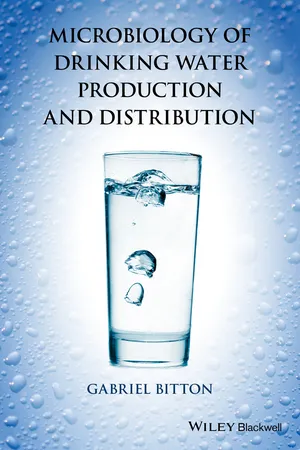
- English
- ePUB (mobile friendly)
- Available on iOS & Android
About this book
Microbiology of Drinking Water Production and Distribution addresses the public health aspects of drinking water treatment and distribution. It explains the different water treatment processes, such as pretreatment, coagulation, flocculation, sedimentation, filtration, disinfection, and their impacts on waterborne microbial pathogens and parasites. Drinking water quality may be degraded in water distribution systems—microorganisms form biofilms within distribution systems that allow them to flourish. Various methodologies have been proposed to assess the bacterial growth potential in water distribution systems. Microbiology of Drinking Water Production and Distribution also places drinking water quality and public health issues in context; it addresses the effect of bioterrorism on drinking water safety, particularly safeguards that are in place to protect consumers against the microbial agents involved. In addition, the text delves into research on drinking water quality in developing countries and the low-cost treatment technologies that could save lives. The text also examines the microbiological water quality of bottled water, often misunderstood by the public at large.
Frequently asked questions
- Essential is ideal for learners and professionals who enjoy exploring a wide range of subjects. Access the Essential Library with 800,000+ trusted titles and best-sellers across business, personal growth, and the humanities. Includes unlimited reading time and Standard Read Aloud voice.
- Complete: Perfect for advanced learners and researchers needing full, unrestricted access. Unlock 1.4M+ books across hundreds of subjects, including academic and specialized titles. The Complete Plan also includes advanced features like Premium Read Aloud and Research Assistant.
Please note we cannot support devices running on iOS 13 and Android 7 or earlier. Learn more about using the app.
Information
1
MICROBIAL CONTAMINANTS IN DRINKING WATER
1.1 INTRODUCTION
- Drinking water source (see Chapter 2).
- Inadequate treatment in the water treatment plant.
- Water distribution system (WDS): Treated water quality may deteriorate in the distribution system. Pathogens and parasites may be introduced into treated water through cracks in the water pipes, back-siphonage or cross-contamination.
- Biofilm development which may alter water quality.
1.2 TRANSMISSION ROUTES OF PATHOGENS AND PARASITES

1.2.1 Person-to-Person Transmission
1.2.2 Waterborne Transmission
- Waterborne diseases: Infections with microbial pathogens may result in gastrointestinal problems (e.g., diarrhea) or in systemic illnesses (e.g., hepatitis caused by viruses; kidney failure resulting from infection with Escherichia coli O157:H7) (Krewski et al., 2002).
- Water-washed diseases (e.g., trachoma, lice, tick-borne disease) linked to poor hygiene resulting from poor access to safe water.
- Water-based diseases such as schistosomiasis caused by parasitic worms (e.g., Schistosoma mansoni) that live inside freshwater snails. The infectious form of the worm, called cercariae, contaminates the water and causes infection following contact with the skin. The parasite causes damages in several organs such as the intestines, skin, liver, and the brain.
- Water-related diseases caused by insect vectors that breed in water (e.g., malaria, Dengue fever, yellow fever).
Table of contents
- Cover
- Titlepage
- Copyright
- Dedication
- PREFACE
- 1 MICROBIAL CONTAMINANTS IN DRINKING WATER
- 2 MICROBIOLOGICAL ASPECTS OF DRINKING WATER TREATMENT
- 3 DRINKING WATER DISINFECTION
- 4 DRINKING WATER DISTRIBUTION SYSTEMS: BIOFILM MICROBIOLOGY
- 5 ESTHETIC AND OTHER CONCERNS ASSOCIATED WITH DRINKING WATER TREATMENT AND DISTRIBUTION
- 6 BIOLOGICAL TREATMENT AND BIOSTABILITY OF DRINKING WATER
- 7 BIOTERRORISM AND DRINKING WATER SAFETY
- 8 WATER TREATMENT TECHNOLOGIES FOR DEVELOPING COUNTRIES
- 9 BOTTLED WATER MICROBIOLOGY
- 10 INTRODUCTION TO MICROBIAL RISK ASSESSMENT FOR DRINKING WATER
- REFERENCES
- INDEX
- END USER LICENSE AGREEMENT